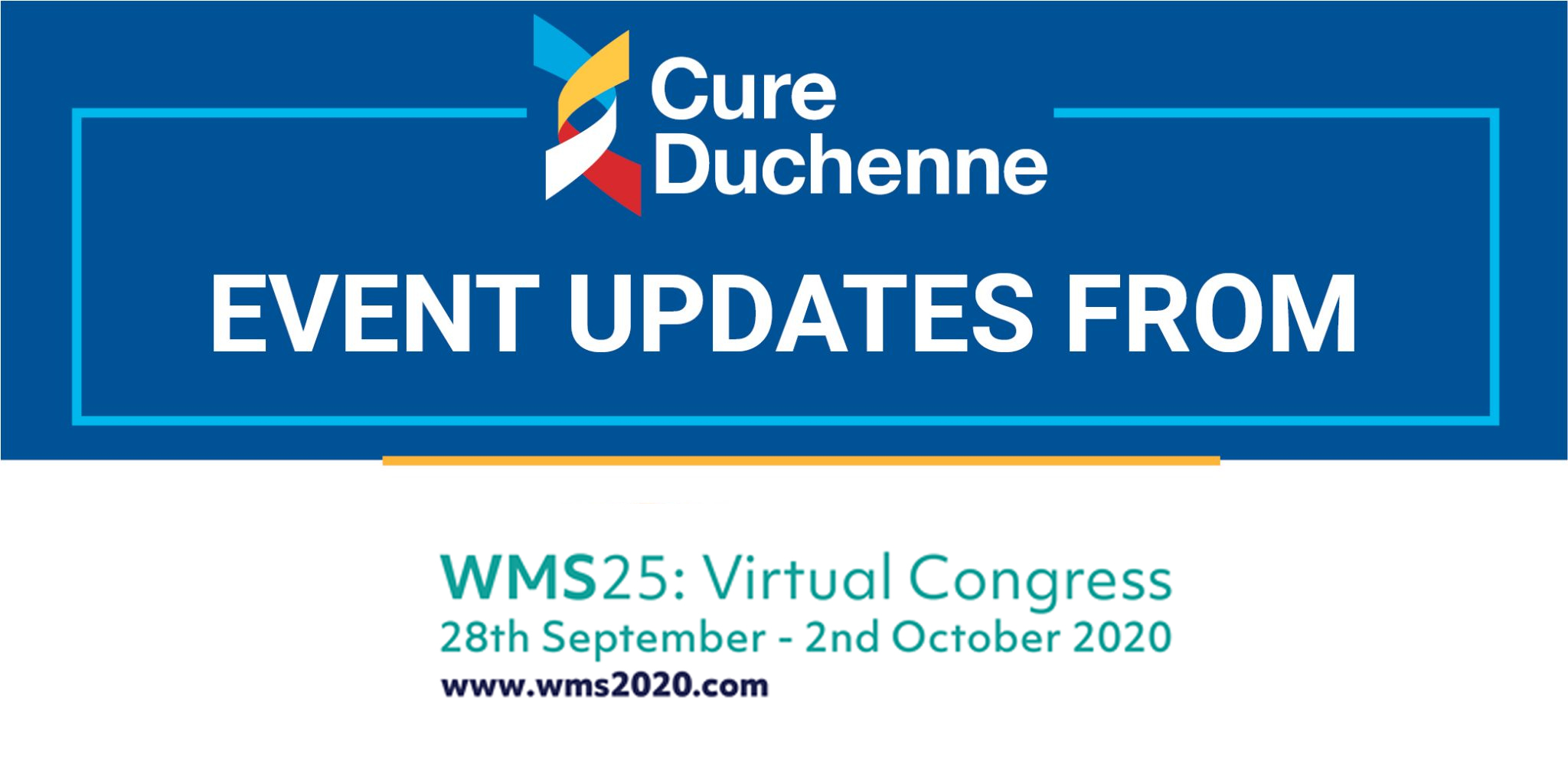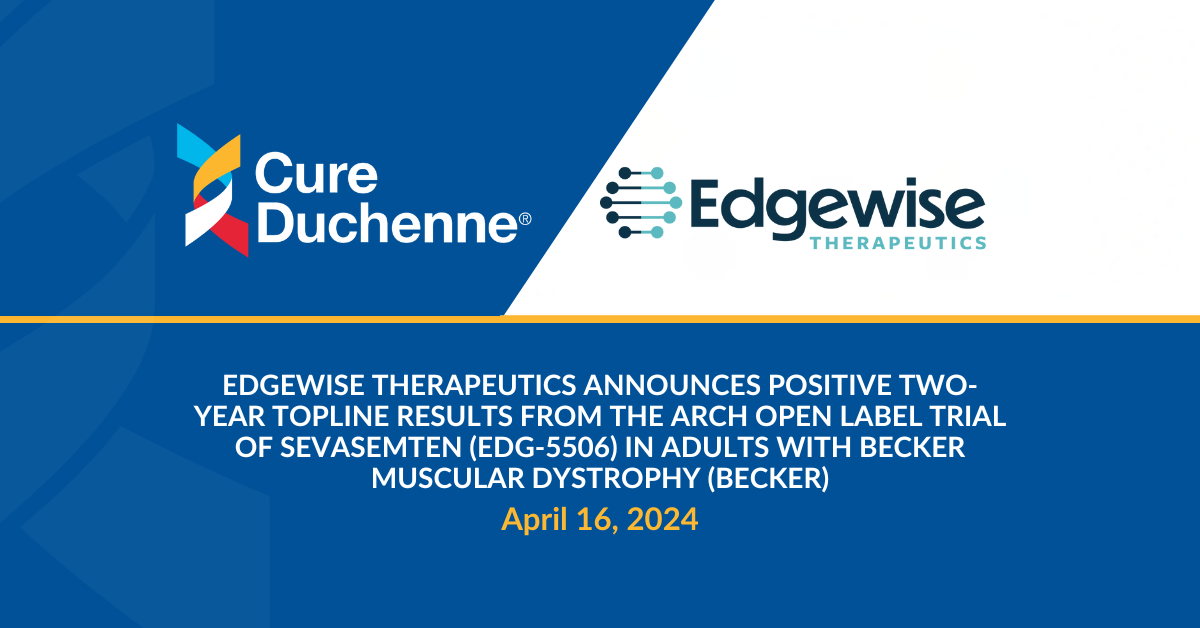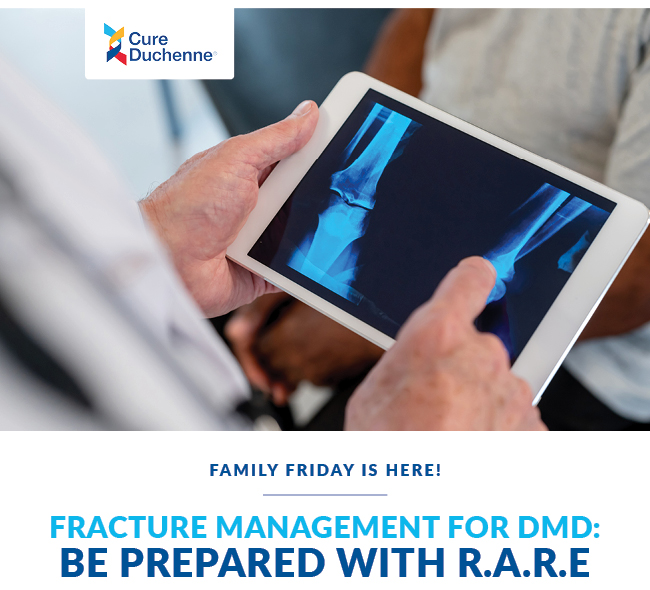Updates from World Muscle Society – 2020

One of the scientific highlights of the fall season for CureDuchenne is the Annual International Congress of the World Muscle Society (WMS). This is the largest annual and international research conference focused solely on neuromuscular disease, and this year is the WMS’s 25th meeting, which is quite a milestone.
However, 2020 is paying no mind to important milestones and yearly traditions, and rather has upended a lot of plans (as we have all learned). So, like most research conferences since last spring, the WMS25 Congress is happening virtually, rather than in Halifax, Canada, as originally planned.
As for the CureDuchenne team, we still plan to make the most out of the virtual WMS25 Congress. We will hear about the latest research developments in Duchenne muscular dystrophy, and network with others in the field. The CureDuchenne team will miss the in-person interactions with so many others who share the same drive to bring transformative treatments to our families, but we know that keeping the community safe and healthy is a critical component of our collective successes.
The organizers of WMS25 have put together an impressive agenda aimed at prompting a lot of discussion. We have counted over 90 poster presentations focused specifically on Duchenne! Our team will be reviewing all the progress and new ideas presented in the talks and posters, and will be reporting back updates throughout the week. So, watch this space for more WMS blog posts.
Importantly, as a Silver sponsor of WMS25, CureDuchenne will be hosting a virtual exhibit booth where attendees can learn about our research and family support programs, such as CureDuchenne Ventures, CureDuchenne Cares, and the CureDuchenne Biobank. Our sponsorship puts us front and center alongside the scientists, researchers, and biopharma industry changemakers working to bring transformative treatments and cures to Duchenne Muscular Dystrophy. Through virtual networking meetings and chats, the CureDuchenne team aims to make the most of our time and valuable connections, to continue to enable progress for the entire Duchenne community.
The Annual International Congress of the World Muscle Society (WMS) kicked off on Monday, September 28, 2020 with a day of Industry Symposia. Two of the six symposia focused on therapeutics in development for Duchenne.
PTC symposium
During PTC’s symposium, promising data was presented from the ongoing STRIDE Registry, which contains individuals taking ataluren in countries where it is available commercially or through an early access program. The STRIDE Registry provides the opportunity to collect data on a wider array of individuals and for a longer time period than is feasible in the controlled clinical trials.
Ataluren is a therapeutic designed to benefit those that have a nonsense mutation creating a premature “stop” in their DMD gene. Ataluren promotes read-through of that “stop” to restore production of full-length dystrophin.
The safety data from this 213 participants in the STRIDE registry (who, on average, have been exposed to ataluren for an average of 639 days at this point) is consistent with that obtained in previous clinical trials, confirming that ataluren is well-tolerated. The functional measures from individuals in the study also suggest that ataluren is effective in slowing disease progression.
For the effectiveness analysis, participants in the STRIDE registry were matched with individuals in the Cooperative International Neuromuscular Research Group (CINRG) natural history study who were comparable in terms of type of mutation (nonsense mutation) similar age of onset of first symptoms, age of initiation of corticosteroids/deflazacort and duration of corticosteroid/deflazacort use. Compared to individuals in CINRG, individuals in the STRIDE registry taking ataluren showed slower progression of disease, including a delay in age of loss of ambulation (by an average of 3.5 years), and delays in reaching 10 second time cutoffs for Time to stand from supine (by average of 4.1 years) and Time to climb 4 stairs (by average of 3.6 years).
Sarepta symposium
During Sarepta’s symposium, promising new data was presented on 4 individuals who were treated with Sarepta’s micro-dystrophin gene therapy in the Phase 1/2 study (Study 101), showing that 2 years out from treatment they are still demonstrating functional improvements.
Study 101 included 4 individuals, 4-6 years of age, treated with SRP9001 at a dose of 2 x 1014 vg/kg in an open-label trial. Sarepta has previously reported the positive safety data, and shown that 90 days after the one-time treatment, mean micro-dystrophin expression was 74.3 – 95.8% of normal (depending on method used) and muscle fibrosis was decreased. They had also reported improvements in functional measures such as the North Star Ambulatory Assessment (NSAA) and timed function tests, at 12 months post-treatment compared to baseline.
Today Sarepta presented the data on the 2-year assessments. Whereas participants demonstrated a NSAA mean increase (improvement) in 5.5 points after one year, after 2 years the mean increase had risen even more, to 7.0. (The NSAA is a validated scale measuring motor abilities in ambulant individuals with DMD, and scores range from 0-34). Compared to baseline, all participants still showed improvements 2 years out. Data was also presented on 100-meter timed test, timed up and go, and 4 stair climb, and many of these individual measures were improved compared to baseline as well.
One of the biggest unknowns with DMD micro-gene replacement therapy is how long will the effects last. Therefore, these findings are very encouraging. It is also noteworthy, though, that the 4 participants reported on today are now between 6 and 8 years of age. The CINRG data shows peak in function around 6 years of age (because scores increase as younger boys are growing and getting stronger). After that, a plateau and then decline is often observed, with the most rapid decline in NSAA between 8-11 years of age. So, it will be critical to continue to monitor these participants to see if they will continue to see gains and/or maintain their strength as they continue to age.
On Wednesday, the World Muscle Society Congress kicked off with an Opening Lecture focusing on the timeliest of topics: COVID-19. The presentation was an effort to summarize the concerns and potential impacts of COVID-19 for the neuromuscular community. To this end, Max Damian of Cambridge University Hospital outlined how individuals with neuromuscular disease are at higher risk, both via potential for more serious symptoms, as well as via consequences due to interruptions in care. On a positive note, COVID-19 has triggered more widespread use of telemedicine and device telemonitoring, and those advances are likely to impact the future of medical practice in ways that will continue to benefit individuals with mobility limitations.
The COVID-19 advice put out by the World Muscle Society, which spans across all neuromuscular disorders, can be found here (https://www.worldmusclesociety.org/news/view/150). CureDuchenne’s own Coronavirus Health Update Guide (https://cureduchenne.org/coronavirus-health-update-guide/) also has Duchenne-specific resources.
Panel discussion on preclinical research
One of the panel discussions of the day focused on the critical importance of rigorous and well-designed experiments in order to build confidence in the evidence that a new experimental drug is safe and effective enough to try in humans.
Amongst the resources discussed were the standardized operating procedures (SOPs) created by the TREAT-NMD network, to help guide the design of experiments in animal models. The intention of the SOPs is help ensure that results would be of high quality and reproducible across laboratories. The SOPs for the Duchenne mdx mice and the Duchenne dog model have been in existence for over 10 years (with updates along the way), and have been downloaded more than 12,000 times from researchers around the world. The CureDuchenne Ventures team has likely contributed to some of that usage, as we often direct researchers and early-stage companies new to the Duchenne field to these SOPs, so that their experiments are consistent with the best standards of the field, lending more confidence in the resulting data.
The Treat-NMD Advisory Committee for Therapeutics (TACT) is also critically valuable for the development of new therapeutics in Duchenne and other neuromuscular disorders. TACT is a group of international academic and industry drug development experts, together with representatives of patient foundations and regulatory experts, who provide formal feedback and guidance to companies on their experimental drugs, translational work and clinical trial designs. The goals are to provide companies with the collective insights from experts in the neuromuscular fields, and to help them avoid pitfalls which may hamper their chances for a successful trial.
CureDuchenne is proud to be a funder of TACT, and CureDuchenne’s Chief Scientific Officer Mike Kelly is a core member of the TACT review committee.
On Thursday, the CureDuchenne team spent time reviewing the research posters presented at the World Muscle Society Congress. Of the 347 posters presented at the conference, more than a quarter of them were relevant to Duchenne and/or Becker muscular dystrophy, which is indicative of the robust research and drug development in these disease fields. Some notable presentations are highlighted below.
Hope-2 one-year results (Capricor Therapeutics)
In the “late-breaking-news” poster session, Capricor Therapeutics reported 12-month data from their recently completed HOPE-2 randomized, placebo-controlled clinical study with CAP-1002 – a cell therapy designed to improve muscle function in older Duchenne patients.
At 12 months, CAP-1002 treatment resulted in statistically significant differences versus placebo by cardiac MRI in mean left ventricular (LV) ejection fraction (mean change from baseline: -0.33% versus -1.89%; D=1.56%; p=0.004), greater reductions in indexed LV end-diastolic volume (D=7.35 mL/m2; p=0.070), LV end-systolic volume (D=6.31 mL; p=0.0045), and indexed LV end-systolic volume (4.80 mL/m2; p=0.0122). LV end-systolic volume is often used as a surrogate for LV remodeling in clinical trials evaluating cardiac outcomes. There was a marked decrease in the cardiac specific creatine kinase-MB isozyme biomarker in CAP-1002-treated patients compared to the placebo treated patient’s indicative of reduced cardiac muscle damage over the course of the study. These results demonstrated that CAP-1002 therapy is safe and effective in treating deterioration of upper limb and cardiac function in older DMD patients. (Poster LBP5 https://www.nmd-journal.com/article/S0960-8966(20)30600-3/fulltext)
Characterization of novel exon-51 skipping AON’s (BioMarin Pharmaceuticals)
Also in the “late-breaking-news” poster session, BioMarin Pharmaceuticals introduced two new exon-51 skipping oligonucleotides (B152575 and B152869) that safely rescue dystrophin expression in the hDMDdel52 mdx mouse model. This “humanized” mouse model contains the full human DMD gene lacking exon 52 and is especially useful for testing antisense oligonucleotides targeting exon 51 on the human gene.
Male hDMDdel52 mdx mice were treated with either B152575 or B152869 for 13 weeks and demonstrated 30% dystrophin expression in quadricep and gastrocnemius muscle and approximately 6% dystrophin restoration in the heart. This was accompanied with a significant improvement in functional motor endpoints after treatment.
The new AON compounds were well tolerated in mice and monkeys and showed dose-proportional pharmacokinetics in plasma and tissue. (Poster LBP7 https://www.nmd-journal.com/article/S0960-8966(20)30602-7/fulltext)
New animal models of Duchenne muscular dystrophy
A number of different posters reported the creation and characterization of novel animal models of Duchenne muscular dystrophy. These are important because they represent different types of mutations and aspects of the disease seen in humans, and broaden the opportunity for development of different types of therapeutics.
Researchers from Creteil, France reported a new rat model of DMD containing a deletion in exon 52. The R-DMDdel52 rat lacks dystrophin, has reduced motor function, and dies by 1 year of age due the severity of the disease. Skeletal muscle show fibrosis, chronic inflammation, adipose deposition, atrophy, fiber type switching and decreased ability to regenerate. Thus, these animals recapitulate more of aspects of human disease, including a deficit in muscle regeneration not observed in mdx and other mice models. This is the third rat model that has been reported in recent years, and as they become more fully characterized, they should prove useful for therapeutic development. (Poster LSP1 https://cslide.ctimeetingtech.com/wms20/attendee/eposter/poster/497?r=pt%7E43)
Two mouse models developed at The Hospital for Sick Children in Toronto were presented in the session “DMD-Animal models & Preclinical treatment.” First, the DMD ∆52-54 mouse, carries a deletion in exons 52 thru 54 observed in human DMD cases. The resulting mouse lacks dystrophin, has muscle dystrophic pathology, and deficits skeletal and cardiac function. The researchers then tested an exon 55 skipping approach in these mice (using an AAV9 delivered CRISPR/Cas9) to show that exon 55 skipping in the DMD ∆52-54 mouse restores dystrophin expression. (Poster 218 https://www.nmd-journal.com/article/S0960-8966(20)30415-6/fulltext)
The second mouse model developed by the Toronto researchers contains a multi-exon duplication in exons 18 thru 30 in the DMD gene. This Dup18-30 mouse also recapitulates a human mutation. The mice display a lack of dystrophin in skeletal muscle and heart, a dystrophic phenotype, and motor deficits. When the researchers delivered an AAV- CRISPR/Cas9 single sg-RNA to remove the duplicated exons (leaving only one copy of exons 18-30), dystrophin expression was restored in both heart and skeletal muscle, resulting in less muscle dystrophy and improved motor behavior. (Poster 220 https://www.nmd-journal.com/article/S0960-8966(20)30417-X/fulltext)
It has been a full week of Duchenne updates at the World Muscle Society Congress (WMS25), and the final day did not disappoint.
Expression of apparent full-length dystrophin in skeletal muscle in a first-in human gene therapy trial using the scAAV9.U7-ACCA vector
As part of the “Late-Breaking News” session, Megan Waldrop of Nationwide Children’s Hospital presented results from two individuals treated with an experimental AAV-delivered exon-skipping therapy designed to target duplications in exon 2 of the DMD gene.
Exonic duplications in the DMD gene are thought to cause up to 11% of all DMD cases, and duplications in exon 2 are the most common among these (approximately 10% of all duplication mutations).
U7 small-nuclear RNA (U7snRNA) interferes with the machinery cells use to appropriately splice genes, and in this case the U7snRNA was packaged inside an AAV9 virus, together with components targeting it to the relevant areas of exon 2. The goal was to eliminate the “extra” copy of exon 2 and restore proper expression of the gene. Researchers at Nationwide Children’s Hospital and Ohio State University had previously shown that this vector (AAV9.U7, ACCA) was effective in restoring dystrophin expression in mice containing a duplication in exon 2. At this WMS25 conference, they also presented data showing it was safe and effective when given to non-human primates (https://www.nmd-journal.com/article/S0960-8966(20)30411-9/fulltext).
All of this preclinical work paved the way for this treatment to be tried in humans, and to date two individuals have received scAAV-U7-ACCA at a dose of 3×1013vg/kg. The treatment was well tolerated, and 3-month data was presented.
Throughout the 3 months, both individuals have experienced a sustained decrease in creatine kinase (CK) levels. Functional outcome measures, including the North Star Ambulatory Assessment (NSAA), the 100 meter walk/run test, and the pulmonary forced vital capacity (FVC) were stable or showed slight improvements. Videos provided from one of the participant’s family also showed apparent improvement while climbing stairs.
An increase in full-length dystrophin expression was also observed, although more robustly in the younger of the two participants. (The two participants were 8.9 and 13.7 years old at treatment). A more complete quantitative analysis of the muscle biopsies is underway.
Although preliminary, the data presented today supports further clinical investigation of scAAV9.U7-ACCA, particularlyin younger subjects and perhaps at higher doses. In addition to these researchers’ efforts, Audentes Therapeutics is also developing a similar therapy (AT702) for individuals with duplications in exon 2 and mutations in exon 1-5 of the DMD gene.
More generally, this work also lends promise to broadening the use of AAV-delivered U7snRNA exon-skipping machinery to other types of mutations in the DMD gene. For example, the next summary describes preclinical work using this approach to skip exon 44 in the DMD gene in mice.
AAV.U7 technology for mutational hotspots of the DMD gene results in efficient exon skipping, protein restoration and force improvement.
Researchers at Nationwide Children’s, Ohio State and UCLA focused on skipping exon 44 of the human DMD gene using five different AAV.U7 constructs in Duchenne patient derived cell lines in vitro as well as in vivo in a new mouse model (hDMDdel45 mdx mice) specifically designed for the study. This mouse, a “humanized” version of the mdx mouse contains the full human DMD gene lacking exon 45 and is especially useful for testing antisense oligonucleotides targeting exon 44 on the human gene.
Intramuscular injection of AAV1.U7-ex44 resulted in efficient exon skipping and this was accompanied with improvements in muscle force measurements three months post injection. Future studies will examine systemic delivery of the U7 constructs, looking for changes in the dystrophic phenotype of the mouse. (https://www.nmd-journal.com/article/S0960-8966(20)30405-3/fulltext)




